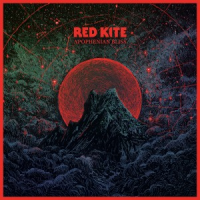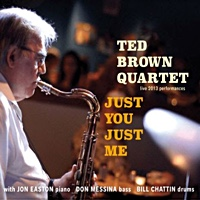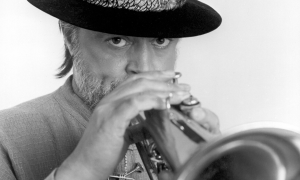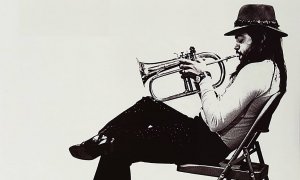Home » Jazz Articles » Catching Up With » Giorgos Tabakis: Moovin' With The Eight-String
Giorgos Tabakis: Moovin' With The Eight-String

I feel more like a student who is constantly learning and has a curiosity for new stuff.
—Giorgos Tabakis
All About Jazz: Your musical journey began at an early age—how did it start?
Giorgos Tabakis: I was fortunate enough to have my first contact with the guitar at the age of nine. My mother's belief was that music balances the human soul, and she suggested I learn the guitar. I went to the small conservatory in my home-town, Nafpaktos (central Greece). There, I met Costas Eliades. He became my teacher for years and is still a special friend. Now, he is the conductor of the wonderful Underground Youth Orchestra, and the director of the label Efkrassis Productions, which has released most of my CDs. Costas was the reason I fell in love with the guitar in the first place. He unveiled to me the beauty of music and helped me to experience it at a young age. This feeling is still with me, stronger than ever.
AAJ: Are your from a musical family?
GT: No, not at all. But for some reason both me and my brother Achilleas—he is a great bassist—have been playing and studying music since we were kids. My father and mother listened to Greek folk music, and I have all these sounds, pictures, memories, smells and many other elements in me, often becoming a source of inspiration.
AAJ: You started your training playing classical guitar—when and how did the switch to jazz come about?
GT: Since I was twelve. Alongside with my classical studies, I was intrigued by the electric guitar and rock music—the '90s was a great time for rock music. I played a lot in my teens in local rock scenes, bars and clubs with bands that me and my friends were forming. Good times! A few years later, I listened to some top guitarists like John McLaughlin, Egberto Gismonti, and others, and I was blown away by their sound, attitude, artistic personality, and music! I immediately felt a strong attraction to follow the freedom these music genres offered me.
Even though I studied jazz guitar for years, I never thought of myself as a jazz player. I like and enjoy styles from a very large music spectrum, feeling amazed every time I listen to something new and interesting, searching a lot for music that will make me feel surprised by its uniqueness. All these sounds, elements and impressions are "filtered" inside me, producing new ideas to work on. I want to compose and perform music that reflects my inner world—something like a personal cultural signature—embracing aspects of contemporary genres without worrying about labels. My classical and jazz training helped me greatly in this pursuit.
AAJ: Can you tell me about Andreas Georgiou—what did you learn from him?
GT: Andreas is an outstanding musician, composer and improviser. I met him when I was eighteen years old. After a few years we reconnected—I was twenty-three and I studied various aspects of modern music with him for years, including advanced theory, classical and jazz harmony, composition techniques, jazz and contemporary guitar, music philosophy and aesthetics and much more. All this helped and allowed me to built a personal connection with music and art in general. He taught me how to search for the desired musical results. Through his international collaborations, I met in person huge musicians like Eberhard Weber, Paul McCandless and Mark Walker from the group Oregon and many others.
AAJ: What are the additional challenges and possibilities of playing an 8-string guitar?
GT: It is a new and different world. The possibilities are endless and every approach is possible. On the other hand, it is a difficult task, and a guitarist should be willing to put a huge effort in order to create an artistic outcome that stands out. Experimenting with the eight-string guitar makes me able to look at it and "see" a different instrument than the guitar I am used to. Playing chords, voicings and much more can become a whole new experience. In my perspective, with the deep basses, very high notes and everything in between, the eight-string guitar presents a great number of emerging abilities and possibilities in today's music canvas. Instruments like this require a deeply personal "touch" and approach, a need to search. Otherwise you don't know what to do with it.
AAJ: What made you choose a GT 8 MOOV guitar?
GT: Yorgos Bechlivanoglou is an international level classical guitarist, the luthier of the Moov guitars and a friend of mine. I played his beautiful six-string Moov guitar for a year or so and I was obsessed with it. Wonderful sound, unique aesthetics and top level playability! I wanted for a long time an eight-string (I played seven-string guitars for years) and I proposed that he build me an eight-string Moov guitar with a specific tuning and other structural alterations. After six months, it was ready to be played. He was kind enough to dedicate this guitar to me, putting my initials as a model name and the GT eight-string Moov guitar was born! I am in love with this instrument!
AAJ: You've also mastered many other instruments. Does learning additional instruments bring new ideas?
GT: I couldn't say that I have mastered an instrument, not even the guitar. Knowing the music giants that have walked this earth, I wouldn't dare to think something like that. I feel more like a student who is constantly learning and has a curiosity for new stuff. I have studied and experimented with many instruments and I still do—this includes classical piano, many types of guitar, the Indian sitar & sarod, the aboriginal didjeridoo, the ancient Greek lyra and many more. Each instrument offers a different view of music and invites me to discover its unique expressiveness. This process expands my musical perception and can bring new ideas and fresh musical concepts.
AAJ: Can you tell me about the compositions on hEre nOw theN—what was your writing process?
GT: The title itself and the material of hEre nOw theN are driven by the issue of the perception of time, the series of experiences, the events of life. It came to me when I was working on the compositions, as l had a strange feeling that l "remembered" the music that had not yet been written. It was an endless searching process to explore the guitar's potentials, and that led me to create some new techniques—like the five-finger arpeggios and others—applying them as a basis of the compositions and improvisations. I wanted to maximize the "orchestral" sound the eight-string guitar offered and to externalise the music I was already listening to in my head, creating a highly personal music outcome—something that could sound like "more that a guitar." It was a difficult but magical process.
AAJ: How and where did you record the album?
GT: I recorded in January 2021, during a long and hard quarantine we had in Greece. The studio belongs to Giotis Paraskevaidis. He is my personal guitar tech, sound engineer and above all, a dear friend. We share a mutual respect, and he is able to capture and evolve, through the mixing and mastering, my personal sound. He is great! During these recordings, I didn't use any effects (except on the track "Transiton") or overdubs. Giotis used multiple input sources with different pre-amps and signal paths. He also experimented a lot with the mastering process in order to capture the project's initial sound in the best possible way. I am very pleased with the result.
AAJ: What's next for 2022?
GT: There is a growing interest for hEre nOw theN from festivals and I hope I will be able to perform this material a lot of times. We also have a few gigs scheduled with Rebecca Trescher, starting in February 2022, at the Jazz in Progress festival in Crete, and there are some new projects that hopefully will be presented next year. I m already thinking to make a "follow up" release for solo eight-string guitar. We 'll see. I m always working on new things, it is something that makes me feel creative and happy.
Tags
PREVIOUS / NEXT
Support All About Jazz
 All About Jazz has been a pillar of jazz since 1995, championing it as an art form and, more importantly, supporting the musicians who make it. Our enduring commitment has made "AAJ" one of the most culturally important websites of its kind, read by hundreds of thousands of fans, musicians and industry figures every month.
All About Jazz has been a pillar of jazz since 1995, championing it as an art form and, more importantly, supporting the musicians who make it. Our enduring commitment has made "AAJ" one of the most culturally important websites of its kind, read by hundreds of thousands of fans, musicians and industry figures every month.























